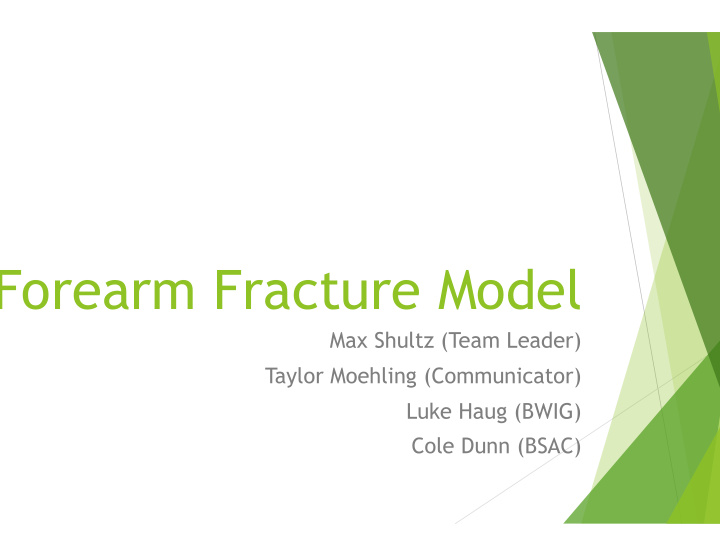



Forearm Fracture Model Max Shultz (Team Leader) Taylor Moehling (Communicator) Luke Haug (BWIG) Cole Dunn (BSAC)
Outline Client Problem Statement Background Design Specifications Final Design/Prototype Testing Goals Fabrication Testing Budget
Client Dr. Matt Halanski Orthopedic Surgeon Clinical Medicine Orthopedic Research Associate Professor
Problem Statement To develop a pediatric forearm fracture model that provides temperature, skin surface pressure and bone alignment feedback for use by medical school residents in order to practice and learn safe, effective casting techniques.
Background 40% of all pediatric fractures occur on the forearm 75% pediatric forearm fractures are distal Both bones or only radius Caused by fall on outstretched hand May include wrist fracture Distal Radius Fracture http://en.wikipedia.org/wiki/Distal_radius_fracture
Background Common in pediatrics causes major public health problem No current teaching model Residents learn to apply and remove casts in situ Complications during casting from inexperience Compartment Syndrome Thermal injuries Skin breakdown Thermal injury from casting http://www.psychologytoday.com/blog/the-red-lig district/201401/penile-fracture-and-9-other-painful-in
Design Specifications Primary Focus: Increased usability for residents Applied force output-make portable Visual map of forearm and corresponding pressure Improved computer interface Secondary Focus: Temperature detection Protection for sensors Representation of skin tissue Alignment detection
Final Design Testing setup with circuit, arduino, and hinge inserted in Platsil mold Force Data Collection 10 Force Sensitive Resistors Arduino Processing Computer display with force readings for each of the 10 sensors, live data with color
Final Design Fracture Representation Platsil mold and hinge fracture model made of wooden dowel “Hinge” system Wooden dowel Tissue Representation Platsil (silicone mold rubber) Platsil mold with 10 sensors (with bumpers) attached clustered around wrist Mold from a 9 year old female
Testing Point load comparison Place weight on FSR (no bumper) on small CSA Place weight on FSR with Force data collected when applied at 5 different locations on FSR sensors with and without bump distribute the force equally bumper Calibration of FSRs Weight from 1-2000g Measured voltage output Calibration curve to convert V out to force Calibration curve
Testing Consistency of FSR readings Vary resistance of hinge and correct ‘fracture’ Record force necessary for each trial Compare force values at different resistances Testing setup with computer and fracture model
Goals-Fabrication 32 smaller FSR Attach sensors on tray Spandex sleeve 4 pockets for inserts Tray inserted into fitted pocket Tray insert with 8 sensors, most coverage on distal and proximal ends due to hand placement during reduction
Goals-Fabrication Transportable pressure system Develop wireless system Display range of standardization of pressure on screen Color display of arm Pressure data corresponds to location on arm Strategic placement of sensors around Dr. Halanski’s hand placement during fracture reduction a typical grip
Goals-Testing Prove precision Use device with multiple orthopedic surgeons 10 trials per doctor and minimum of 3 doctors Sample mean and standard deviation shows variability T-test to verify subjects do not reject null hypothesis: u 1 =u 2 =u 3 … ( α =0.05) Confidence intervals to obtain proper range Range of standardization of pressure on each sensor
Budget Purchased Materials Cost ashers/Screws/Nuts $4.72 ooden Dowel (7/8'' x 48'') $3.38 Vinyl Bumpers $3.96 Arduino MEGA 2560 $40.01 Breadboard w/ wires $8.86 Conductive Rubber Cord $13.77 ound FSRs (15) $102.25 Total $176.95
Acknowledgements Dr. Matt Halanski Professor Mitchell Tyler Gabe Bautista Professor Tom Yen Shlomi Laufer Dr. Carla Pugh Lab COE Student Shop Michael Bauer
References [1] Biomed Central. (October, 2010 30). Pattern of fractures across pediatric age groups: analysis of individual and lifestyle factors . Retrieved from http://www.biomedcentral.com/1471-2458/10/656 [2] Boyd, A. (2009, January 01). Principles of casting and splinting . Retrieved from http://www.aafp.org/afp/2009/0101/p16.html [3] Wright, M. (July, 2010 16). Forearm injuries and fractures . Retrieved from http://www.patient.co.uk/doctor/Forearm-Injuries-and-Fractures.htm
Recommend
More recommend